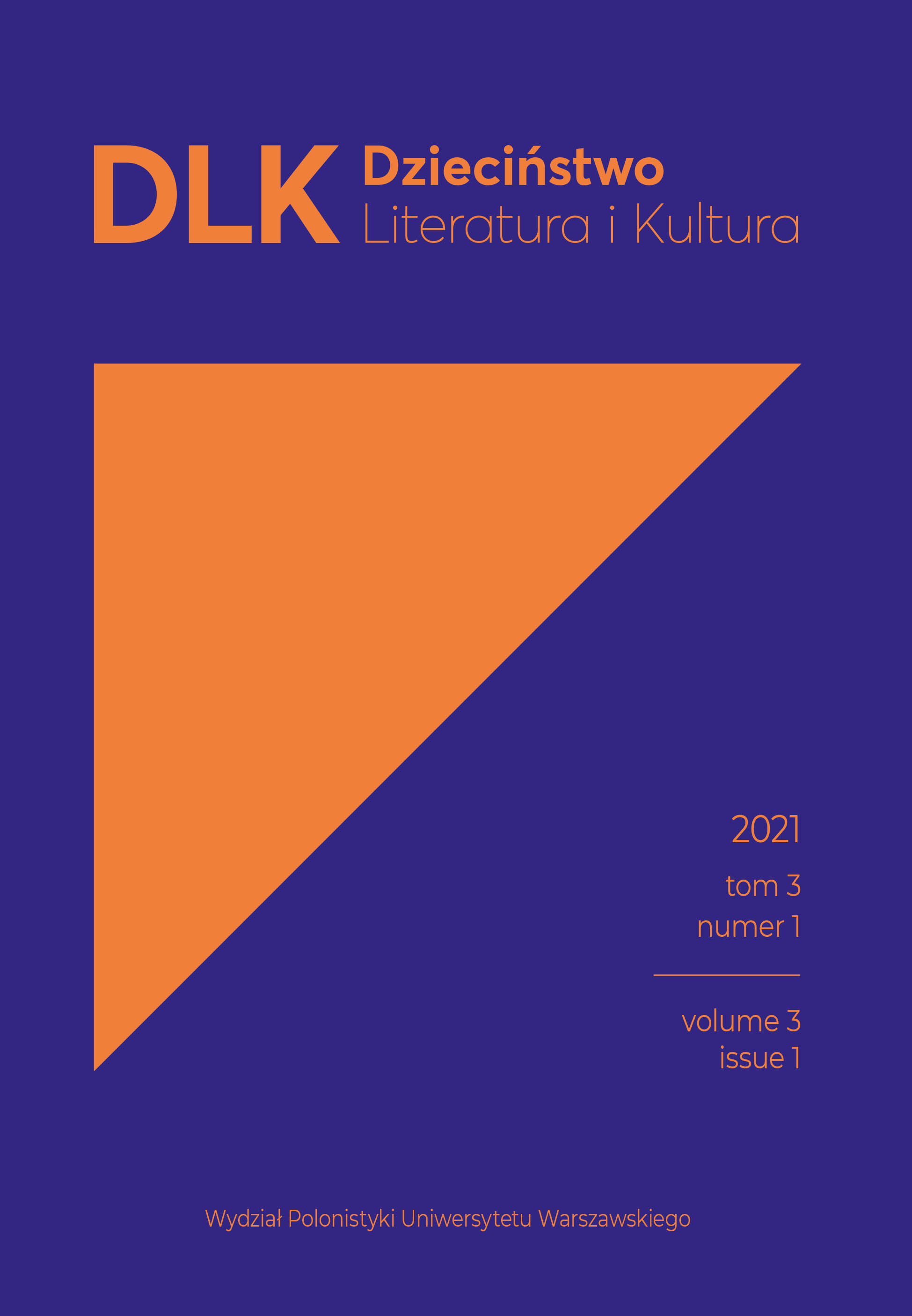Multicultural Childhood in The Arab of the Future by Riad Sattouf
Abstract
The subject of this article is Riad Sattouf’s multi-volume autobiographical graphic novel The Arab of the Future (2014– ), the author’s account of his childhood spent in a mixed family and two different countries and cultures, Syrian and French. The first part of the paper reflects on the concepts of narrative identity and Otherness, including the Otherness of the child, in the context of the ‘redrawn,’ double narrative characteristic of the autobiographical graphic novel. The second part examines how Sattouf employs the form of a comic book, first to define his identity by creating a coherent narrative, and second, to tell the reader about his experience of the Otherness related to growing up in two different cultures.
Received: 15.01.2022
Accepted: 25.03.2022
Keywords
The Arab of the Future; autobiography; childhood; Otherness; comic book; graphic novel; Riad Sattouf; narrative identity
References
Barbieri, D. (2001). Literature and comics: The less-obvious differences. W: C. J. F. Jorge, C. Zurbach (red.), Actas do IV Congresso Internacional da Associaçao Portuguesa de Literatura Comparada “Estudios Literários / Estudios Culturais” (t. 3, s. [1–10]). Universidade de Évora.
Bauman, Z. (2000). Ponowoczesność jako źródło cierpień (J. Margański, tłum.). Wydawnictwo Sic!. (wyd. oryg. 1997).
Bauman, Z. (2016). Obcy u naszych drzwi (W. Mincer, tłum.). WN PWN.
Błażejczyk, M. (2002). Przeciąganie liny, czyli narrator w komiksie, Zeszyty Komiksowe. Pobrane 17 sierpnia 2022 z: https://www.zeszytykomiksowe.org/narracja.
Chrobak, M. (2014). Ucząc się od Jurgielewiczowej. Inna w powieści Katarzyny Pranič Ela-Sanela. W: B. Niesporek-Szamburska, M. Wójcik-Dudek M.(red.), A. Zok-Smoła (współpr. red.), Wyczytać świat – międzykulturowość w literaturze dla dzieci i młodzieży (s. 81–95). Wydawnictwo UŚ.
Chrobak, M. (2015). Obcość jako kategoria interpretacyjna w badaniach nad dzieciństwem i literaturą dla dzieci, W: J. Sztachelska, K. Szymborska (red.), Children Studies jako perspektywa interpretacyjna. Studia i szkice (s. 55–66). Wydawnictwo UwB.
Domańska, E. (2005) Mikrohistorie. Spotkania w międzyświatach. Wydawnictwo Poznańskie.
Kostecka, W. (2021) Czym jest wielokulturowa literatura dziecięca i młodzieżowa i jak ją badać? Propozycje metodologiczne z perspektywy literaturoznawczej w kontekście polskim. Wielogłos, 47(1), 123–149. https://doi.org/10.4467/2084395XWI.21.006.13581.
Lejeune, P. (1975). Pakt autobiograficzny (A. W. Labuda, tłum.). Teksty, 23(5), 31–49. (wyd. oryg. 1973).
Lejeune, P. (2007). Wariacje na temat pewnego paktu. O autobiografii (R. Lubas-Bartoszyńska, wstęp i red., W. Grajewski, S. Jaworski, A. Labuda, R. Lubas-Bartoszyń ska, tłum.). TAiWPN Universitas.
Leszczyński, G. (2006). Kulturowy obraz dziecka i dzieciństwa w literaturze drugiej połowy XIX i w XX w. Wybrane problemy. Wydział Polonistyki UW.
Lubas-Bartoszyńska, R. (2003). Tożsamość i autobiografia. Przestrzenie Teorii, 2, 138–157.
Lubas-Bartoszyńska, R. (2007). Wstęp. W: P. Lejeune, Wariacje na temat pewnego paktu. O autobiografii (R. Lubas-Bartoszyńska, wstęp i red., W. Grajewski, S. Ja worski, A. Labuda, R. Lubas-Bartoszyńska, tłum., s. v–xxi). TAiWPN Universitas.
Ricoeur, P. (1993). Życie w poszukiwaniu opowieści (E. Wolicka, tłum.). Logos i Ethos, 2, 225–235. (wyd. oryg. 1986).
Ricoeur, P. (2005). O sobie samym jako innym (B. Chełstowski, tłum.). WN PWN. (wyd. oryg. 1990).
Sattouf, R. (2004). Ma circoncision. Bréal jeunesse.
Sattouf, R. (2016). Arab przyszłości. Dzieciństwo na Bliskim Wschodzie (1978–1984) (O. Mysłowska, tłum.). Kultura Gniewu. (wyd. oryg. 2014).
Sattouf, R. (2018). Arab przyszłości 2. Dzieciństwo na Bliskim Wschodzie (1984–1985) (O. Mysłowska, tłum.). Kultura Gniewu. (wyd. oryg. 2015).
Sattouf, R. (2019). Arab przyszłości 3. Dzieciństwo na Bliskim Wschodzie (1985–1987) (O. Mysłowska, tłum.). Kultura Gniewu. (wyd. oryg. 2016).
Shacter, D. L. (2003). Siedem grzechów pamięci. Jak zapominamy i zapamiętujemy (E. Haman, J. Rączaszek-Leonardi, tłum.). PIW. (wyd. oryg. 2001).
Still, E. J. (2017). Riad Sattouf’s L’Arabe du futur, bodily humour, and a politics of socio-symbolic adolescence. Francosphères, 6(1), 35–60. https://doi.org/10.3828/franc.2017.5.
Szyłak, J. (1998). Komiks. Świat przerysowany. Słowo/Obraz Terytoria.
Stevan, C. (2018). Riad Sattouf: «Avant d’être Syrien ou Français, je suis dessinateur». Le Temps. Pobrane 17 sierpnia 2022 z: https://www.letemps.ch/culture/riad-sat touf-detre-syrien-francais-suis-dessinateur.
Tuszyńska, K. (2016). Narracja w powieści graficznej. WN PWN.
University of Warsaw Poland
https://orcid.org/0000-0001-6983-0297
Joanna Kierska – MA, graduate of the Faculty of Polish Studies at the University of Warsaw and the Unit of Formation and Research (UFR) in Slavic Studies at the Sorbonne University (France), student of Italian studies at the University of Warsaw. Contact: jm.kierska@student.uw.edu.pl.

This work is licensed under a Creative Commons Attribution 4.0 International License.
Open Access Policy
All articles presented on the pages of ”Dzieciństwo. Literatura i Kultura” are published in open access under a Creative Commons license - Attribution 4.0 International (CC BY 4.0). It means that:
- they can be made available and quoted under the condition of explicit and clear indication of the author/authors of the referenced text;
- you cannot use legal or technological means that would limit others in using the text under the terms of the license.
More information: https://creativecommons.org/licenses/by/4.0/





